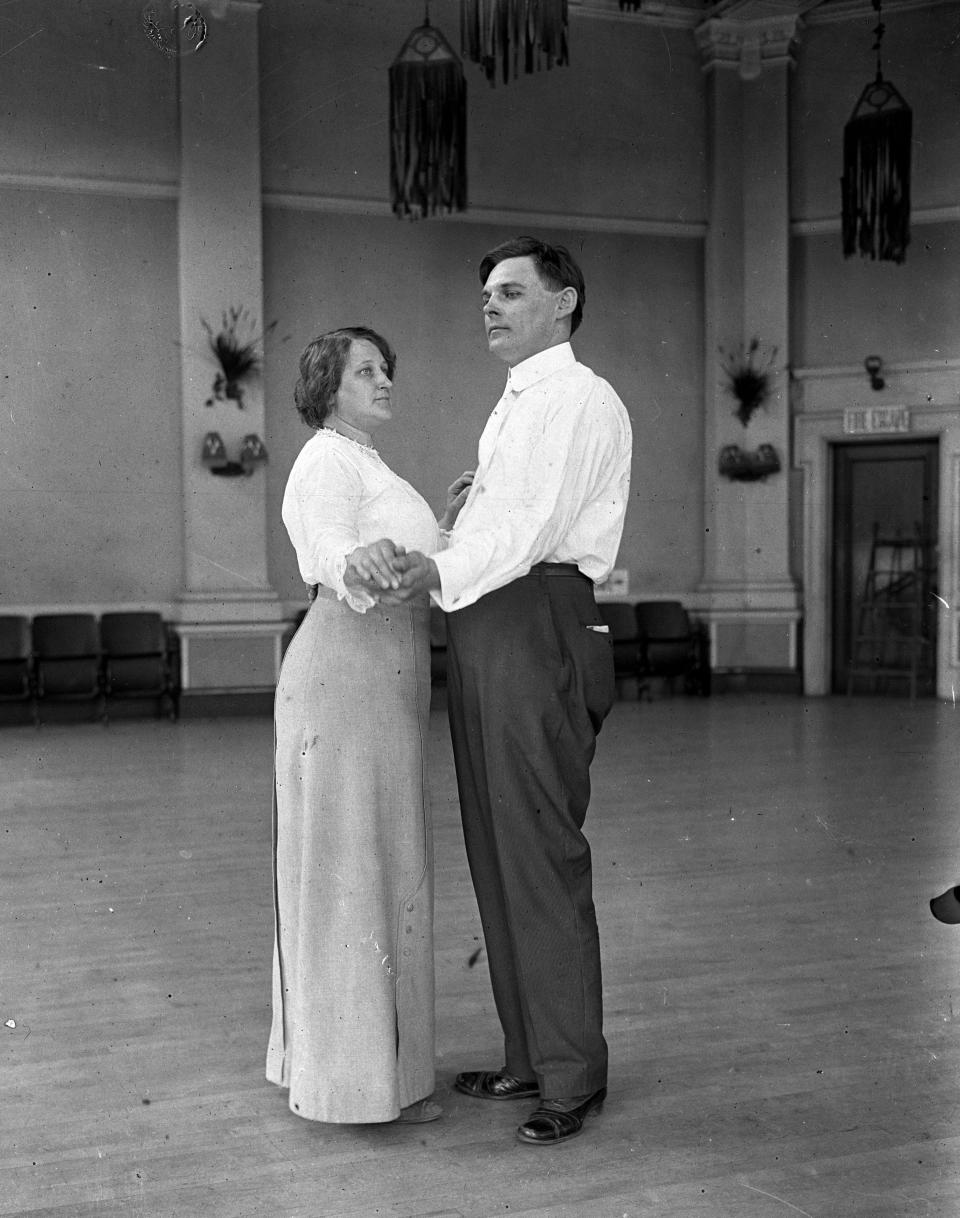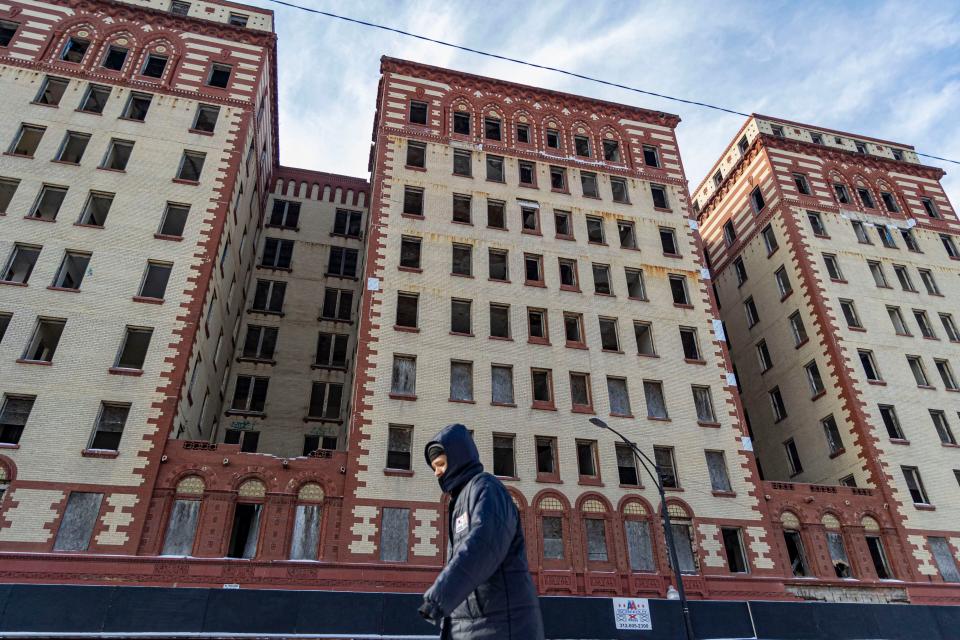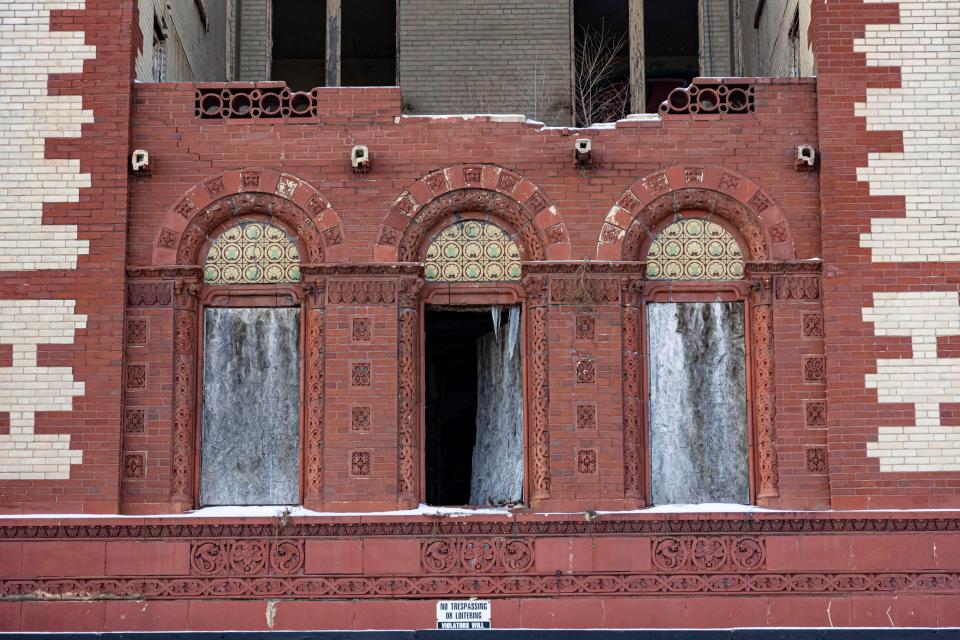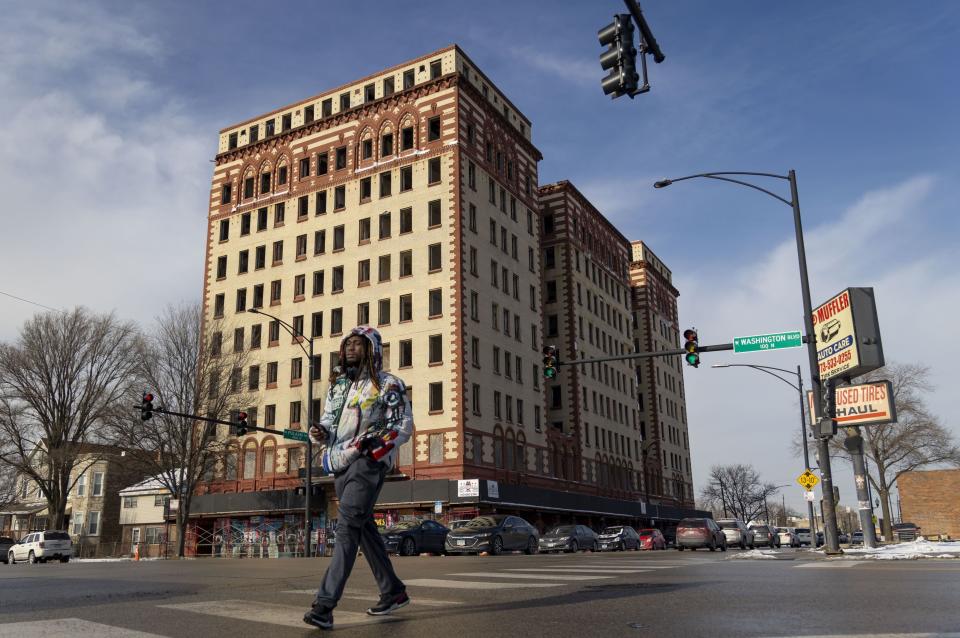Jimmy Carter slept here, and other tales from the Guyon Hotel in West Garfield Park
The Hotel Guyon was built on a conviction that there was money to be made in catering to middle-class aspirations. In 1928, high-rise living was a prerogative of the well-to-do. They inhabited lakefront towers, some topped with penthouses, on the North Side and in Hyde Park.
Chicago’s middle class resided inland. Yet J. Louis Guyon purposely plunked down a 289-room, 10-story hotel in the unlikely landscape of West Garfield Park — a mélange of single-family homes, two- and three-story flats and apartments.
Like nothing within eyesight, the Hotel Guyon had a mammoth footprint. Its “red and cream brick with deep red terra cotta detailing” ran north and west of the intersection of Washington Boulevard and Crawford Avenue, later renamed Pulaski.
The Tribune saluted the project for forgoing penthouses. “On the roof are to be two bungalows, one of twelve rooms, the other of nine. Mr. Guyon will live in the larger.”
Despite the rich symbolism of that substitution — modest bungalows for ritzy penthouses — Guyon’s project had cash-flow problems from Day One.
Guyon’s timing was not great — the Great Depression began shortly after his building was completed. Rents affordable to middle-class tenants didn’t cover the cost of maintaining the building and paying dividends on the million dollars in bonds Guyon issued to finance its construction. Bondholders sued, and within a few years of the building’s opening, the company that had underwritten the bonds forced the hotel into receivership.
That started a spiral of defaults and refinancings. Its multiroom suites were cut up, and it ended as an single room occupancy hotel. Renters got a room barely big enough for a bed. A 1972 fire destroyed the ballroom and other parts of the building. Today it stands empty.
Nonetheless, it maintains the exotic flourishes that the Tribune attributed to the architect Jens Jensen (who shared a name with a famed landscape architect) having “hied himself off to the land of the Moors for his architectural motif.”
But its windows now lack even a sliver of glass. They look like eyes haunted by a question a passerby might pose: “If these walls could only talk, what tales would they tell?”
Louis Guyon’s story contradicts the reigning narrative of the Jazz Age as a decade when America drowned its Victorian heritage in bathtub gin. A ballroom-dancing teacher, he owned Guyon’s Paradise Ballroom on Crawford Avenue, just north of his hotel.
Its dance floor could accommodate 4,000, but couples had to watch their step, literally. Guyon forbade “any form of dance or any position which permits the gentleman to walk directly in front of his partner,” according to an advertisement for his ballroom.
By his definition, that included not only the palpably sensuous shimmy, Charleston and tango but also the rather sedate fox trot. The waltz and the two-step were allowed.
Nor was he willing to allow other ballroom owners to accept or forbid dances as they saw fit.
For Guyon, prudish dancing was a moral crusade. “When you are told that youth of both sexes — can mingle in close embrace with bosoms and abdomens in friction and with limbs intertwined, and survive the experience without mental, moral and physical pollution, you know the teller LIES,” he wrote.
Such was his zeal that Archbishop James Quigley in 1913 had to deny that the Catholic archdiocese had denounced the tango. Guy acknowledged writing a letter on the subject but denied attributing it to the church or sending it out.
When there was talk in the City Council of an official ban on the tango, Guyon wrote an essay in the Tribune refuting the argument that a dance hall without the tango couldn’t be profitable.
“But I point out to you that fact that in a world apparent gone jazz mad, I have and am conducting one of the largest and most profitable ballrooms in the country in which jazz music and jazz dancing have never been allowed or taught.”
The other side of the argument was supported by the head of the Chicago Dancing Masters Association, who publicly demonstrated the dance. He “had many young persons with him who cheered his statements to the effect that it was the evil in Guyon’s mind that caused him to see evil in the tango,” the Tribune reported in 1913.
Guyon lost his pulpit in 1934 when his hotel with ballrooms on two floors and a notorious celebrity on its guest list went into receivership.
Shortly after it opened, the police had raided Jack McGurn’s four-room suite. They found a machine gun, an automatic pistol and an automatic rifle. A “made man” in Al Capone’s mob, his moniker was “Machine Gun Jack McGurn.”
“The detective seized McGurn who was in golfing togs and William Burke, 33, who said he was a licensed prize fight referee, as they were about to sit down to a dinner Mrs. McGurn had prepared,” the Tribune reported. “McGurn told the detectives he felt the need for an arsenal in his rooms to protect himself.”
He had narrowly escaped the bullets of a hit ordered by rival gangsters, the reporter explained.
Guyon’s dance hall also intersected with mob history.
In 1929, a shotgun-toting robber forced a porter sweeping the floor to open the door to his accomplices, who hammered a hole in its brick vault. “Clambering inside the vault, they applied torches to the back of the safe and cut a hole after four hours’ work.” They got away with $7,102.
The next year, a bomb exploded in the Paradise Ballroom just before opening while the band was rehearsing.
“James C. Petrillo, president of the Chicago Federation of Musicians Union, who had declared a strike against the hall, denied any knowledge of the bombing when questioned by prosecutors yesterday,” the Tribune reported. “Musicians now employed are members of the American Musicians Union, which Petrillo said is not a recognized union.”
In addition to making mayhem headlines, the Guyon Hotel and adjacent ballroom witnessed the anonymous disasters and triumphs of an ordinary person’s life.
In 1953, Mr. and Mrs. Anton Pecina celebrated their golden wedding anniversary with a reception for about 300 at the Paradise Ballroom.
“Both have lived their whole lives on the West Side,” the Tribune noted. “Pecina, 73, is a maintenance man.”
The romantic ambience of a ballroom echoes with proclamations of love, not all of them sincere. In 1945, Frank Gordon met Pearl Bencsics, a widow, at the Paradise Ballroom. He proposed and got her to sign a promissory note to pay a $200 debt.
Though virtually indigent, she lent him $850 to buy a car he said he needed for work. When he was a no-show on their wedding day, she called the police.
Gordon told the detectives who came to her home that he loved her and wanted to speak to her.
“I don’t want to talk to him,” Bencsics replied. “He’s already talked me out of $1,050.”
The Guyon Hotel was added to the National Register of Historic Places in May 1985. The following year, the hotel briefly garnered headlines when former President Jimmy Carter and his wife stayed there while joining Habitat for Humanity volunteers building four housing units at Maypole and Kildare streets.
“Large patches of broken plaster were missing from the walls and the carpeting was worn through in the hallway leading to the apartment,” the Tribune observed. “Gang graffiti was scrawled on the elevator and stairwell.”
In more recent years, the building has appeared regularly on the “most endangered” lists of city and state preservation groups, and remains in need of a guardian angel. Last March, bricks fell off the hotel and came crashing through neighboring homes. Presumably they are due compensation — from a property owner under order to file a structural engineer’s report on the Guyon Hotel, faded, empty and creaking under the burden of unpaid taxes and fines.
Have an idea for Vintage Chicago Tribune? Share it with Ron Grossman and Marianne Mather at rgrossman@chicagotribune.com and mmather@chicagotribune.com.






